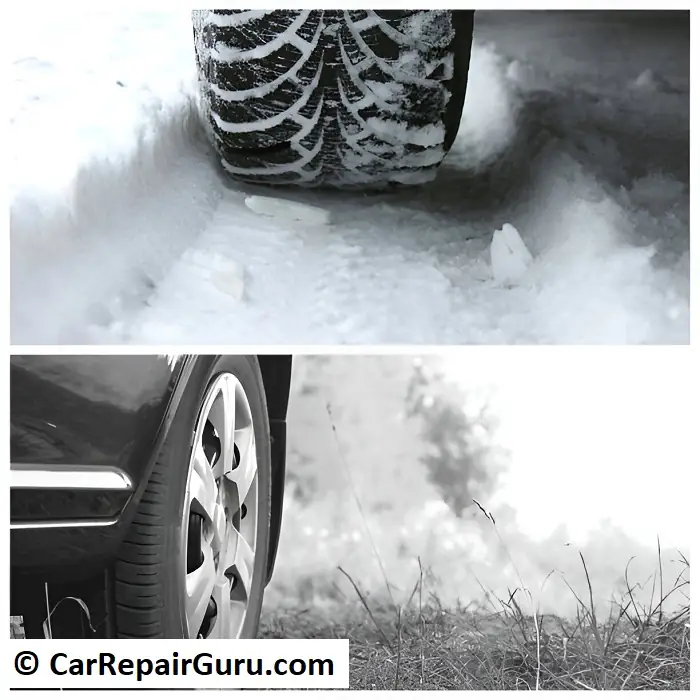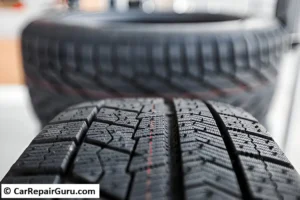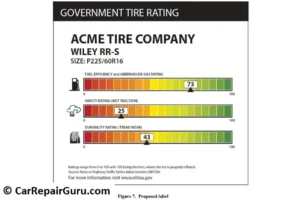
Choosing the right tires for your vehicle isn’t just a matter of preference—it’s a critical decision that impacts your safety, fuel efficiency, and overall driving experience. Tires are the only point of contact between your car and the road, making their performance essential for handling and stability in all conditions.
Different seasons bring unique challenges. From icy winter roads to the scorching heat of summer, your tires need to be equipped to handle temperature changes and road conditions. This is where understanding the differences between winter tires and summer tires becomes essential.
Winter tires are designed to offer superior grip and traction in cold, snowy, and icy conditions, while summer tires excel in providing optimal performance on dry and wet roads during warmer months. In this guide, we’ll explore the key differences between these two types of tires, helping you make an informed choice for safe and efficient driving year-round.
What Are Summer Tires?
Summer tires are specifically engineered to deliver exceptional performance in warm weather conditions. Made from a unique rubber compound, these tires remain firm at higher temperatures, providing optimal grip and precise handling on dry and wet roads.
One of the standout features of summer tires is their tread design. Unlike winter tires, summer tires have shallower tread depths and fewer grooves, which maximizes the contact patch with the road. This design enhances cornering, braking, and acceleration, making summer tires ideal for performance-oriented driving.
In warm conditions, summer tires offer numerous advantages. Their increased traction improves fuel efficiency, while their responsive handling ensures a smooth and enjoyable ride. Additionally, they perform exceptionally well on rain-slicked roads due to specialized tread patterns that reduce the risk of hydroplaning.
However, summer tires have limitations. They are not suitable for cold weather as the rubber hardens in low temperatures, significantly reducing traction. Furthermore, their shallow tread depth means they wear out faster than winter or all-season tires, especially when exposed to rough or uneven surfaces.
Overall, summer tires are an excellent choice for drivers in regions with mild climates, offering unparalleled performance and safety during the warmer months.
What Are Winter Tires?
Winter tires, also known as snow tires, are specially designed to provide superior performance and safety in cold, icy, and snowy conditions. These tires are crafted from a unique rubber compound that remains pliable in temperatures below 45°F (7°C), ensuring optimal grip on frozen surfaces.
One of the defining characteristics of winter tires is their aggressive tread pattern. With deeper grooves and numerous sipes (small slits), they are built to bite into snow and ice, offering exceptional traction and stability. This design also helps channel slush and water away from the tire’s surface, reducing the risk of hydroplaning.
In cold weather conditions, winter tires outperform both summer and all-season tires. Their ability to maintain flexibility and provide superior grip on slippery roads significantly enhances braking performance and cornering stability. This makes them indispensable for drivers in regions that experience harsh winters.
However, winter tires are not without drawbacks. They wear out quickly on dry, warm roads due to their softer rubber compound, making them unsuitable for year-round use. Additionally, they may produce more road noise compared to other tires.
Despite these limitations, winter tires are a must-have for navigating treacherous winter roads safely, offering peace of mind and reliable performance in extreme conditions.
Key Differences Between Summer and Winter Tires

When comparing summer and winter tires, three primary differences stand out: rubber compound, tread design, and performance metrics. Understanding these distinctions can help you choose the best tires for your driving needs and environmental conditions.
Rubber Compound
The rubber compound used in tires significantly influences their performance. Summer tires are made from a firmer compound that softens in warm weather, providing excellent grip and handling. However, in cold temperatures, this compound hardens, reducing traction and making summer tires unsafe for winter use. Conversely, winter tires use a softer compound that remains flexible even in subzero conditions, allowing them to maintain traction on icy and snowy roads.
Tread Design
The tread patterns of summer and winter tires are optimized for their respective seasons. Summer tires feature shallow tread depths and minimal sipes, maximizing contact with the road for better grip, handling, and fuel efficiency. Winter tires, on the other hand, have deeper treads and numerous sipes to improve traction by biting into snow and ice. Their grooves also help channel slush and water, reducing the risk of hydroplaning.
Performance Metrics
Summer and winter tires are designed to excel in different conditions. On dry or wet warm roads, summer tires offer shorter braking distances, responsive handling, and superior grip. However, they struggle in icy or snowy environments. Winter tires shine in cold weather, providing reliable braking and stability on slippery surfaces. While their performance is unmatched in winter conditions, they may feel less responsive and wear out faster on dry or warm roads.
By understanding these key differences, you can make an informed decision about which tires to use based on your climate and driving needs, ensuring safety and optimal vehicle performance year-round.
When to Use Summer Tires
Summer tires are specifically designed to perform at their best in warm weather conditions, typically when temperatures consistently stay above 45°F (7°C). Their firmer rubber compound and shallow tread patterns make them ideal for dry and wet roads during the warmer months.
These tires are most effective in scenarios where precise handling, responsive braking, and enhanced traction are essential. For instance, summer tires are a great choice for city driving, highway cruising, and high-performance sports cars. Their design allows for optimal grip on smooth, dry asphalt, and they excel in wet conditions by dispersing water to prevent hydroplaning.
However, summer tires are not suited for cold or icy conditions, as the rubber hardens at lower temperatures, compromising grip and safety. To ensure maximum performance and safety, switch to summer tires once winter conditions have passed and temperatures consistently remain in the recommended range.
When to Use Winter Tires

Winter tires are designed to perform optimally in cold weather, particularly when temperatures drop below 45°F (7°C). Their specialized rubber compound remains flexible in freezing conditions, ensuring consistent grip and traction on icy, snowy, or slushy roads.
These tires are best suited for driving scenarios where winter weather poses significant challenges. If you frequently navigate snowy mountain passes, icy city streets, or rural roads blanketed in snow, winter tires are indispensable. They provide superior braking performance and stability, reducing the risk of accidents in hazardous conditions.
Winter tires are also ideal for areas that experience prolonged cold seasons or unpredictable weather with sudden temperature drops. However, they should be removed once the weather warms up, as their softer compound wears out quickly on dry, warm pavement. For maximum safety and performance, switch to winter tires at the onset of cold weather and use them until temperatures consistently rise above their recommended range.
The Role of All-Season Tires
All-season tires are a versatile option designed to provide a balanced performance in a variety of weather conditions. They combine elements of both summer and winter tires, making them suitable for drivers who experience mild climates without extreme seasonal changes.
These tires are made with a rubber compound that remains flexible across a broad temperature range. Their tread pattern features moderate grooves and sipes, allowing them to handle light snow, rain, and dry roads reasonably well. While they don’t match the specialized performance of summer tires in warm weather or winter tires in freezing conditions, all-season tires offer a convenient middle ground.
Compared to summer tires, all-season tires sacrifice some dry and wet road performance for the ability to handle light winter conditions. Similarly, they don’t provide the same level of traction and braking power as winter tires on icy or snowy roads. However, for regions with moderate weather and infrequent snowfalls, they are an economical and practical choice.
All-season tires are best suited for drivers in temperate climates where temperatures rarely drop below freezing or rise to extreme highs. While not ideal for specialized performance, they offer convenience and year-round usability for everyday driving needs.
Impact on Fuel Efficiency and Tire Wear

Your choice of tires significantly affects your vehicle’s fuel efficiency and the lifespan of the tires themselves. Each type of tire—summer, winter, and all-season—performs differently based on its design and intended use.
Fuel Efficiency
Summer tires are typically the most fuel-efficient option for warm weather. Their shallow tread patterns and optimized rubber compounds reduce rolling resistance, requiring less energy to move the vehicle forward. This leads to better fuel economy, especially on dry or wet roads. Winter tires, however, have deeper treads and softer rubber compounds, which increase rolling resistance. While this design enhances traction in icy or snowy conditions, it can lead to reduced fuel efficiency, particularly on dry or warm roads. All-season tires fall somewhere in between, offering moderate rolling resistance but not matching the efficiency of summer tires in optimal conditions.
Tire Wear and Longevity
The longevity of a tire depends heavily on how well it suits the driving environment. Summer tires wear out faster in cold conditions as their hard rubber compounds are not built for low temperatures. Winter tires degrade quickly on dry, warm roads due to their softer rubber. All-season tires offer decent tread life in mild climates, but their durability diminishes in extreme weather. Choosing the right tire for the season not only improves performance but also extends the life of your tires and maximizes cost efficiency.
Legal Considerations and Regulations
In many regions, the use of specific tire types is mandated by law to ensure road safety during certain seasons. For example, in countries with harsh winters, such as Canada, Finland, and Germany, winter tires are legally required during snowy months. These regulations are typically enforced from late autumn to early spring, with fines or penalties for non-compliance.
Some areas also require tires to carry specific certifications, such as the “Three-Peak Mountain Snowflake” (3PMSF) symbol, which indicates that the tire meets winter performance standards.
Conversely, in warmer climates, using studded winter tires is restricted or banned entirely because they can damage road surfaces. Drivers in these areas are encouraged to use summer or all-season tires year-round.
It’s essential to research local laws and adhere to seasonal requirements when selecting your tires. Proper compliance not only avoids legal issues but also ensures safer driving conditions for everyone on the road.
Conclusion
Choosing the right tire type is crucial for ensuring safety, performance, and cost-efficiency. Summer tires excel in warm weather, offering precise handling and fuel efficiency, while winter tires provide unmatched traction and braking in icy, snowy conditions. All-season tires serve as a convenient middle ground for regions with mild climates.
To make the best choice, consider your local climate, typical driving conditions, and seasonal regulations. By using tires suited to the environment, you’ll enjoy safer, more efficient driving and extend the life of your tires. Prioritize your needs to ensure a smooth ride year-round.
FAQs About winter tires vs summer tires
What are the main differences between winter and summer tires?
Winter tires use a softer rubber compound and deeper tread patterns for better grip on snow and ice, while summer tires have firmer rubber and shallow treads optimized for warm, dry, or wet roads.
Can I use winter tires in summer?
No, winter tires wear out quickly on warm roads and provide less precise handling. Switch to summer or all-season tires when temperatures exceed 45°F (7°C).
Are all-season tires a good compromise?
All-season tires perform moderately well in various conditions, making them ideal for mild climates. However, they lack the specialized performance of summer or winter tires.
How do I know when to switch my tires?
Switch to winter tires when temperatures drop below 45°F (7°C) and back to summer or all-season tires when they rise above that range.
Do winter tires improve fuel efficiency?
Winter tires usually lower fuel efficiency due to higher rolling resistance but ensure better traction and safety in cold conditions.






